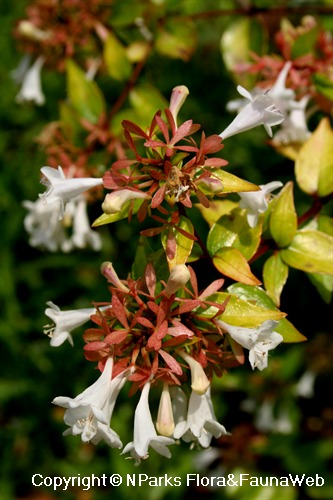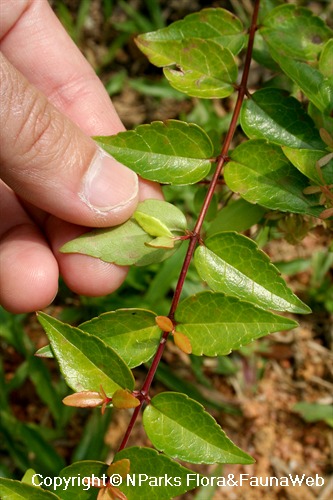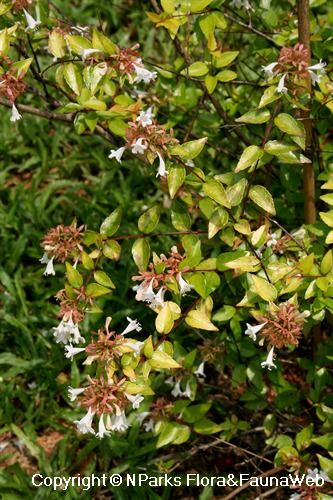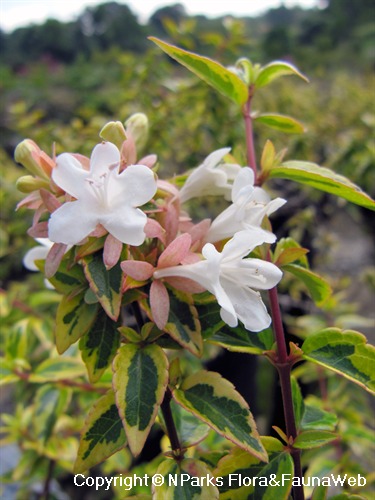
Back
Abelia × grandiflora 'Francis Mason'
| Family Name: | Caprifoliaceae |
| Common Name: | Golden Abelia, Francis Mason Glossy Abelia |
Name
Classifications and Characteristics
| Plant Division | Angiosperms (Flowering Seed Plants) (Dicotyledon) |
|---|---|
| Plant Growth Form | Shrub |
| Lifespan (in Singapore) | Perennial |
| Mode of Nutrition | Autotrophic |
| Plant Shape | Shrubby |
| Maximum Height | 1.5 m |
Description and Ethnobotany
| Growth Form | It is an evergreen or semi-evergreen compact shrub, which grows upright or spreading, to 1-1.5 m tall. |
|---|---|
| Foliage | Leaves are yellow and green, elliptical in shape. |
| Flowers | Small, cluster, white with a tinge of pink tubular flowers |
| Others - Plant Morphology | Latest accepted Family (APGII) should be Linnaeaceae, previously placed in Caprifoliaceae. This is a cultivar of the hybrid cross: Abelia chinensis × Abelia uniflora. |
| Etymology | Genus Abelia is named after Dr. Clarke Abel (1780-1826), who was a physician and writer on China. |
Landscaping Features
| Desirable Plant Features | Ornamental Foliage, Ornamental Flowers |
|---|---|
| Landscape Uses | General, Flowerbed / Border, Container Planting, Hedge / Screening |
| Thematic Landscaping | Golden Garden, Naturalistic Garden |
Fauna, Pollination and Dispersal
| Fauna Pollination Dispersal Associated Fauna | Butterfly-Attracting |
|---|
Plant Care and Propagation
| Light Preference | Full Sun, Semi-Shade |
|---|---|
| Water Preference | Moderate Water |
| Plant Growth Rate | Moderate |
| Rootzone Tolerance | Fertile Loamy Soils, Well-Drained Soils, Acidic (low pH) Soils, Moist Soils |
| Maintenance Requirements | Moderate |
| Pruning | It is advisable to do thinning to stimulate branching. |
| Propagation Method | Stem Cutting |
Foliar
| Foliage Retention | Evergreen |
|---|---|
| Mature Foliage Colour(s) | Green, Yellow / Golden |
| Mature Foliage Texture(s) | Smooth, Glossy / Shiny |
| Prominent Young Flush Colour(s) | Red |
| Foliar Type | Simple / Unifoliate |
| Foliar Arrangement Along Stem | Opposite |
| Foliar Shape(s) | Non-Palm Foliage (Elliptical) |
| Foliar Venation | Pinnate / Net |
| Foliar Margin | Crenate |
| Foliar Apex - Tip | Acuminate |
| Foliar Base | Cuneate |
| Typical Foliar Area | Notophyll ( 20.25cm2 - 45 cm2 ) |
| Leaf Area Index (LAI) for Green Plot Ratio | 4.5 (Shrub & Groundcover - Dicot) |
Non - Foliar and Storage
| Stem Type & Modification | Woody |
|---|---|
| Root Type | Underground (Tap Root, Fibrous Root) |
Floral (Angiosperm)
| Flower & Plant Sexuality | Bisexual Flowers |
| Flower Colour(s) | White |
|---|---|
| Flower Grouping | Cluster / Inflorescence |
| Flower Symmetry | Radial |
| Individual Flower Shape | Tubular |
| Flowering Period | Free-Flowering |
| Flowering Habit | Polycarpic |
| Flower Colour(s) Remarks | Tinge of pink. |
Image Repository
Others
| Master ID | 29154 |
|---|---|
| Species ID | 3463 |
| Flora Disclaimer | The information in this website has been compiled from reliable sources, such as reference works on medicinal plants. It is not a substitute for medical advice or treatment and NParks does not purport to provide any medical advice. Readers should always consult his/her physician before using or consuming a plant for medicinal purposes. |










